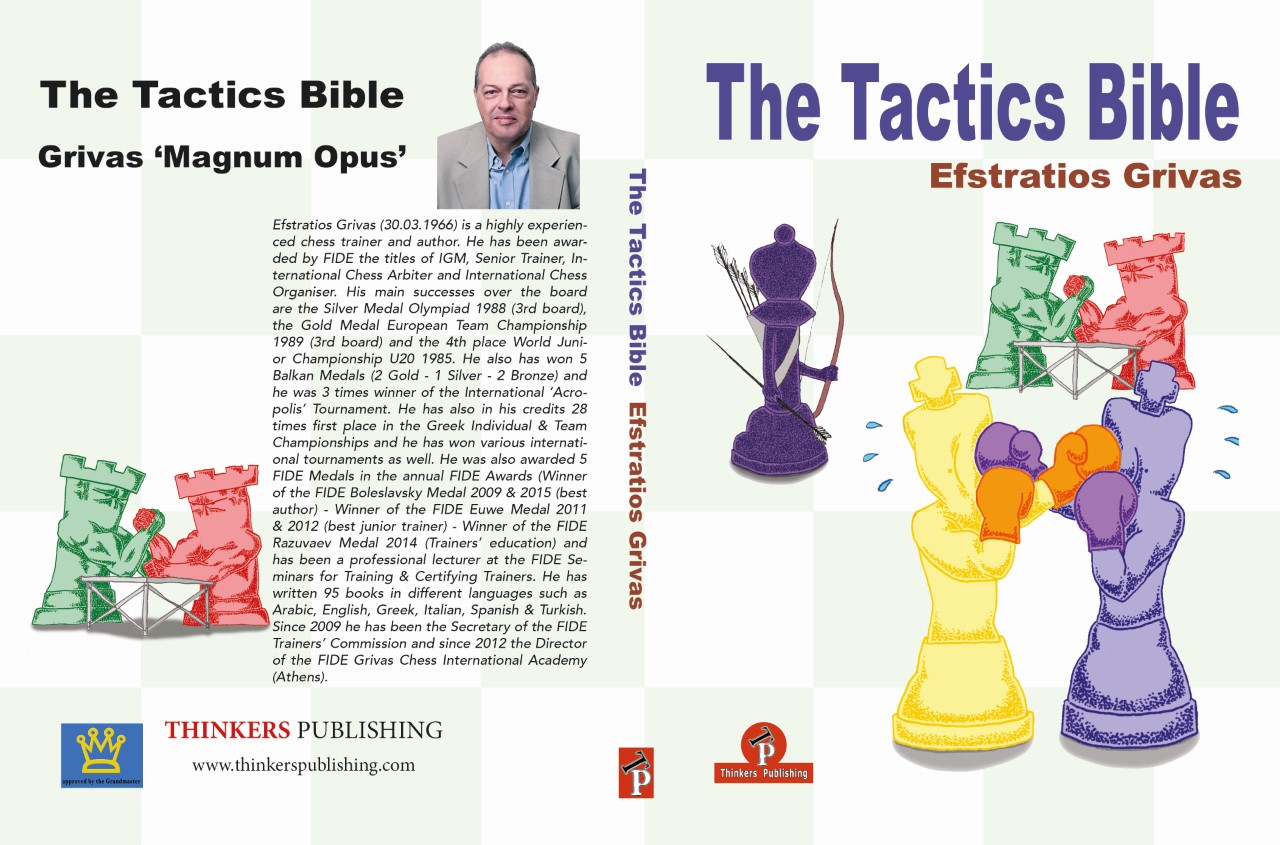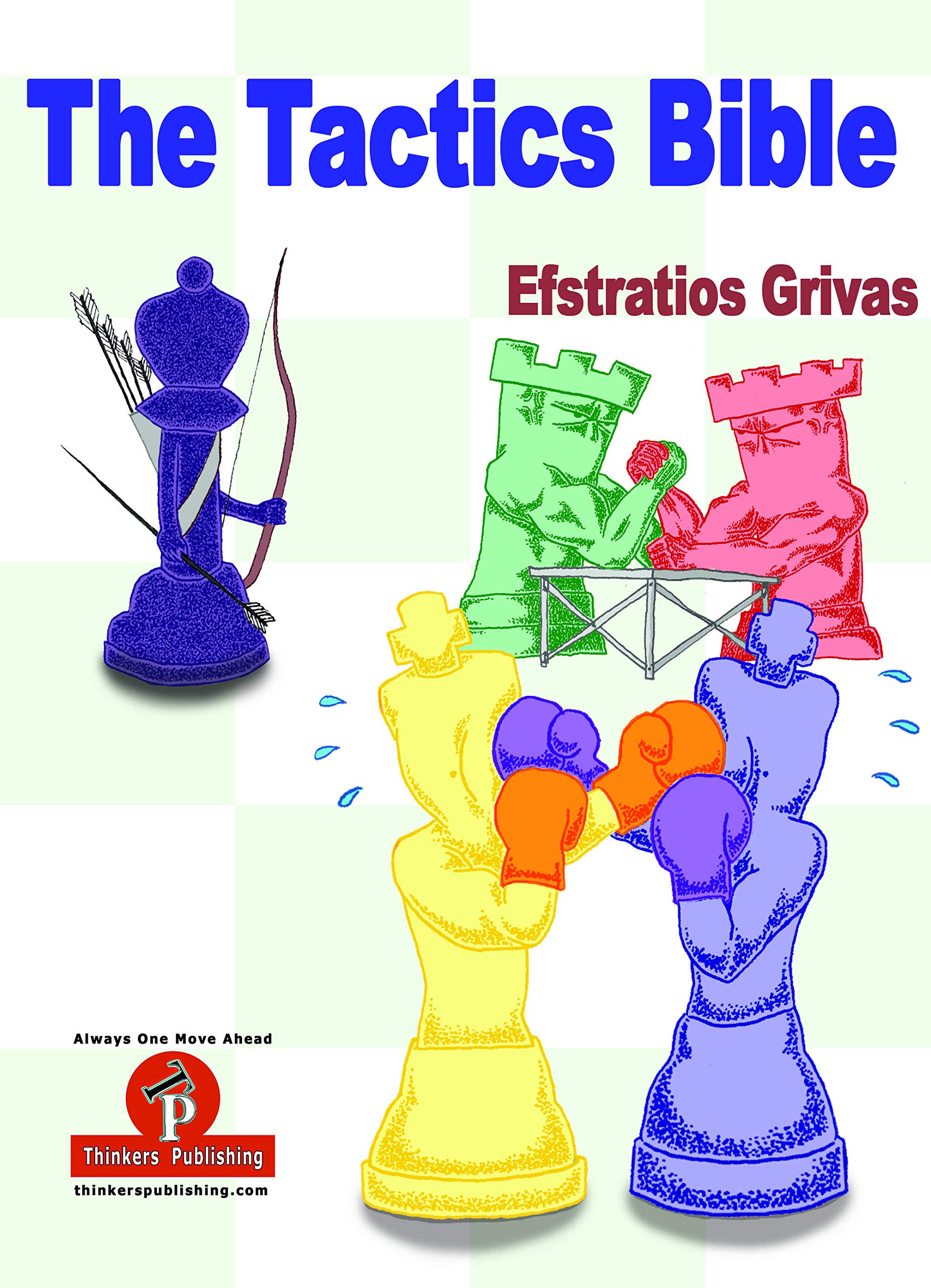
From the publisher:
“Grandmaster Grivas presents the reader an unique and massive amount of amazing puzzles including their historical background. All the most famous and rare tactical themes are covered, promising the read of the year!”
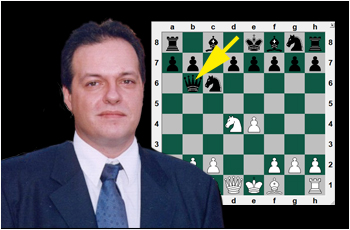
“Efstratios Grivas (30.03.1966) is a highly experienced chess trainer and chess author. He has been awarded by the International Chess Federation (FIDE) the titles of International Chess Grandmaster, FIDE Senior Trainer, International Chess Arbiter and International Chess Organiser.
His main successes over the board are the Silver Medal Olympiad 1998 (3rd Board), the Gold Medal European Team Championship 1989 (3rd Board) and the 4th Position World Junior Championship U.20 1985. He has also won 5 Balkan Medals (2 Gold – 1 Silver – 2 Bronze) and he was 3 times Winner of the International ‘Acropolis’ Tournament. He has also in his credit the 28 times first position in Greek Individual & Team Championships and he has won various international tournaments as well.
He was also been awarded five FIDE Meals in the Annual FIDE Awards (Winner of the FIDE Boleslavsky Medal 2009 & 2015 (best author) – Winner of the FIDE Euwe Medal 2011 & 2012 (best junior trainer) – Winner of the FIDE Razuvaev Medal 2014 (Trainers’ education) and has been a professional Lecturer at FIDE Seminars for Training & Certifying Trainers.
He has written 95 Books in Arabic, English, Greek, Italian, Spanish & Turkish. Since 2009 he is the Secretary of the FIDE Trainers’ Commission and since 2012 the Director of the FIDE Grivas Chess International Academy (Athens).”
This is second book of the author’s I have reviewed. Previously I reviewed “Your Jungle Guide to Rook Endings”
This large tactical tome is action packed full of great tactics and some exciting, instructive games. It is an ideal companion for trainers and players who seek to develop their recognition of dozens of mating patterns. All these mating motifs are shown in constructed cut down diagrams followed by many different examples from real games with the checkmating ideas demonstrated with both colours and rotated to aid practising recognising them in different forms thus helping to form a kind of brain muscle memory for these crucial motifs.
The tactics are taken from a mixture of old classics and modern games.
I expect that most older players can remember going through many tactics/ puzzle books on their road to learning the game and this book is another excellent addition to this genre.
The book is divided into five parts:
- Part 1 A Tactical World
- Part 2 Tactical Play
- Part 3 Basic Mates
- Part 4 Combinative Mates (Queen & Rook)
- Part 5 Combinative Mates (Bishop, Knight and Pawn)
Part 1 A Tactical World is a thoughtful introduction into the world of tactics with thoughts on Tactical Education and a brief history of the development of chess schools of thought.
Four very famous and brilliant games are then presented with objective modern analysis which points out not only the exciting attacking opportunities but also the defensive possibilities. The author is mindful of the fact that tactical patterns help defensive prowess as well as attacking acumen.
The four games are a mixture of old and new:
- The Immortal Game Adolf Anderssen v Lionel Kieseritzky London 1851 (Offhand game)
- The EverGreen Game Adolf Anderssen v Jean Dufresne Berlin 1852 (Offhand game)
- The Rainbow Game Gregory Serper v Ioannis Nikolaisis St Petersburg 1993
- The Chess Game Garry Kasparov v Veselin Topalov Wijk aan Zee 1999
I can remember playing through the two Adolf Anderssen games as a novice and being really impressed by the beautiful combinations and of the course the queen sacrifices. They are a must for any book on tactics.
The two modern games are also superb and are obviously of a much higher defensive standard than the games played in the 1850s.
Garry Kasparov’s win over Veselin Topalov is regarded by many people as his finest game.
The reviewer will not showcase these well known games here as experienced players will be well aware of them and new players should buy the book for a treat. However, I will whet your appetite by showing one position from the Rainbow Game:
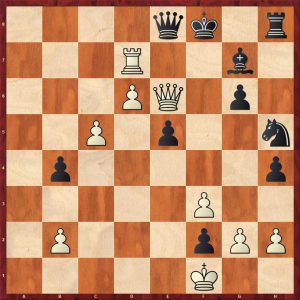
White has sacrificed two pieces for a long term attack and two dangerous passed pawns. Black has just played 29…Qe8. How does white continue the attack?
Part 2 Tactical Play
This chapter examines various aspects of attacking play by presenting examples from real play:
- Attack Via The Edged Files
- Blocking the F6-Square
- Fierce Queen
- King In The Box
- The King Hunt
- The Novotny Interference
- Defence & Counter-Attack
The section Attack Via The Edged Files discusses the opening of lines around the opponent’s king, typically the rook file and tactics associated therein.
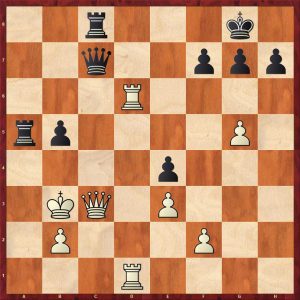
Here is a nice tactic that could easily be missed in practice.
33…Ra3+! 34.Kxa3 Qa7+ 0-1 35.Kb3 Qa4#
The Blocking The F6 section has some entertaining attacking finishes. Here is a vintage Kasparov finish against his old rival Karpov:
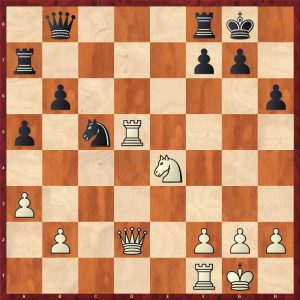
22.Nf6+! Opening up the king (22…Kh8 23.Rh5! mates quickly) 22…gxf6 23.Qxh6 f5 24.Qg5+ Kh8 25.Qf6+ Kg8 26.Rxf5 Ne4
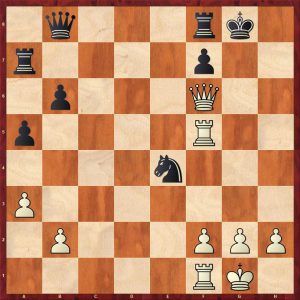
27.Qh4! Re8 28.Rh5 f5 (29.Rh8+ Kf7 30.Qh7+ Kf6 31.Qh6+ Ke5 32.Rd1 and mates soon) 1-0
In the Fierce Queen section, there is an amusing modern mirror of Marshall’s famous 23…Qg3 against Levitsky at Breslau 1912:
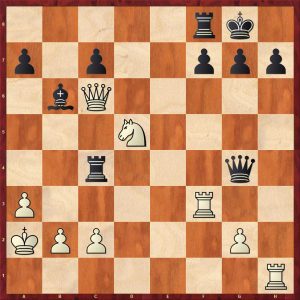
White played 1.Qg6!! Qxg6 (1…fxg6 2. Ne7+ Kh8 3.Rxf8#; 1…hxg6 2.Ne7#; 1…h6 2.Nf6+ Kh8 3.Qh7#) 2.Ne7+ Kh8 3.Nxg6+ Kg8 4.Ne7+ Kh8 5.Rxh7+ Kxh7 6.Rh3+ Rh4 7.Rxh4#
The king in the box section includes a brilliant study by Kasparian which is worth revisiting:
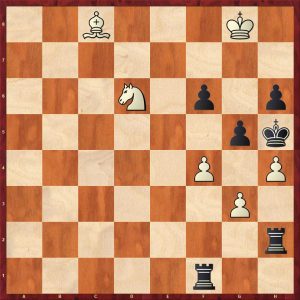
1,Ne8! Kg6 2.h5+! Rxh5 3.f5+! Rx5 4.g4! Re5 5.Bf5+! Rxf5 6.Ng7!
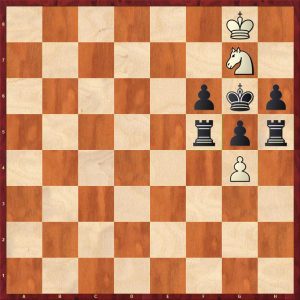
The King Hunt section reminds me of one of my favourite books as a junior player: The King Hunt by W.H. Cozens. Some of the games from that book are included here. I shall show one example here from Lodewijk Prins v Lawrence Day Lugano 1968:
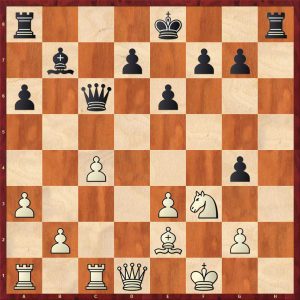
White played the greedy 23.Ne1?? The punishment was a humiliating long, lonely walk to the scaffold for the white king. (23. Kf2 gxf3 24. Bxf3 is about equal) Rh1+ 24.Kf2 g3+! 25.Kxg3 Rxe1! 26.Qxe1 Qxg2+ 27.Kf4 g5+ 28.Ke5 Qe4+ 29.Kf6 (29.Kd6 Rc8 30. b4 Rc6#) Qf5+ 30.Kg7 Qg6+ 31.Kh8 0-0-0# 0-1
A Novotny interference is when the attacking side sacrifices a piece on a square where it can be taken by two different opponent’s pieces – whichever piece captures interferes with the other. Here is a Novotony example that was new to me:
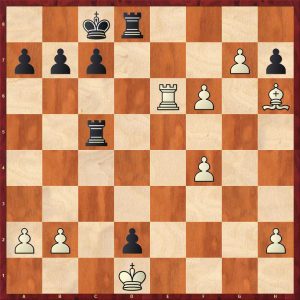
White resigned here as he could not see any defence to 30…Rc1+ 31.Ke2 and 31…d1Q+ winning easily. What did he miss?
He could have won with 30.Rd6!! Rxd6 (30…cxd6 32.f7 wins) 31.g8=Q+ Kd7 32.Qf7+ Kc6 33.Qe8+ Kb6 34.Qe3! pinning the dangerous rook followed by taking it and f7 winning.
The section on the counterattack is didactic and shows some good examples. Here is a game Fischer-Gligoric from Varna 1962.
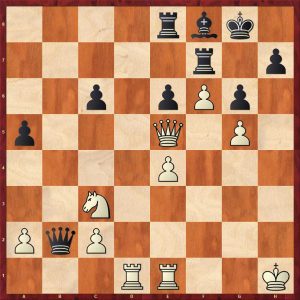
White clearly has had an initiative with active pieces but his attack has been halted and white’s exposed king will become a factor. His knight is also not really contributing much.
27…h6! (Stockfish prefers 27…Bb4 but also likes the move played) 28.Re3 Bb4 29.gxh6 Qxc2 30.Rg1 Kh7
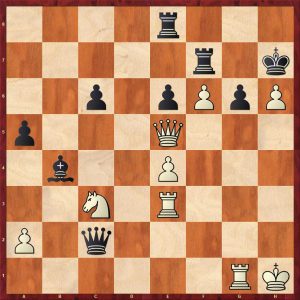
31.Qg3 (31.Rxg6 does not work because white’s king is too exposed: 31…Kxg6 32. Rg3+ Kh7 33. Rg7+ Rxg7 34.hxg7 Qc1+ 35. Kg2 Qd2+ 36.Kf1 Kg6! wins) Rg8 32.e5
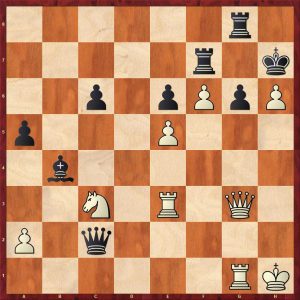
Bxc3! (stopping the knight from getting to g5) 33.Rxc3 Qe4+ 34.Rg2 Rd8! (Very strong, the counterattack is rolling) 35.Re3 Rd1+ 36.Kh2 Qb1 37.Qg4 (37.Rg1 Qxa2+ 38. Kh3 Rxg1 39.Qxg1 a4) Rh1+ 38.Kg3
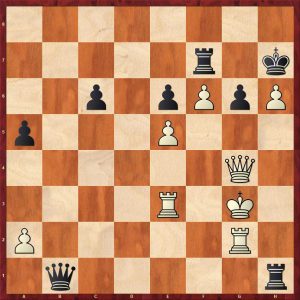
Qc1? (38…Rh5! is more murderous 39.Qe4 Qc1 40.Rf3 Rd7 activating the other rook kills white) 39.Re4? (39.Qd4 is better) Rd7! Bringing up the reserves 40.Qe2 Qg5+ (40…Qxh6 is even more accurate but the game line is good enough) 41.Qg4 Rd3+ 42.Kf2 Rd2+ 43.Kg3 Rxg2+ 44.Kxg2 Qc1 0-1
Part 3 Basic Mates
As the title suggests, it covers basic checkmates. The chapter is divided into two sections covering the fundamental endgame mates with the pieces and common checkmates occurring at the beginning of the game.
A more experienced reader may think this section is too basic but you would be wrong as the author covers some pretty complex stuff in the endgame such as two knights against a pawn.
Grivas has an excellent section on the Bishop & Knight mate which is not trivial by any means. GM Vladimir Epishin failed to win this ending! I will confess that I had never heard of Delétang’s triangles although I am aware of the techniques to confine the king using triangles. I take my hat off the author for explaining the bishop and knight mate so clearly.
This is a surprising stalemate trap not mentioned in endgame manuals:
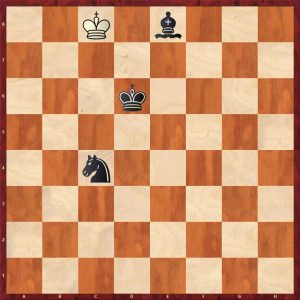
1…Nb6+? 2.Kd8! Oops black can only save his bishop by inflicting stalemate on white! A quick win was to be had: 1…Na5 2.Kd8 Ba4 3.Kc8 Bd7+ 4.Kb8 Kc6 5.Ka7 Bc8 6.Kb8 Kd7 7.Ka8 Kc7 8.Ka7 Nc6+ 9.Ka8 Bb7#
Some basic mates at the beginning of the game are covered such as Fool’s Mate, Scholar’s Mate and similar ideas. Importantly, the author considers the defences to Scholar’s mate. Some GM games are included!
Here is an example from a Greco game which is an offshoot of a foolhardy variation of Owen’s Defence.
Greco – NN
Europe 1620
1.e4 b6 2.d4 Bb7 3.Bd3 f5?
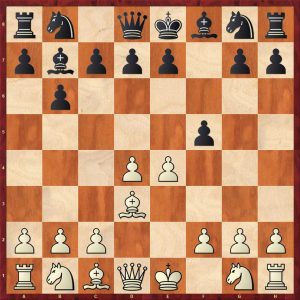
4.exf5! Bxg2 5.Qh5+ g6 6.fxg6 Nf6
6…Bg7 is better, but there are two busts to this silly line:
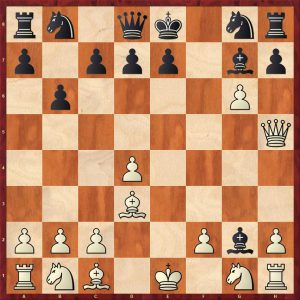
7.gxh7+ Kf8 8.Qg6 or even better 7.Qf5! Nf6 8.Bh6!! Bxh6 9.gxh7 Bxh1 10.Qg6+ Kf8 11.Qxh6+ Kf7 12.Nh3! Qf8 13.Qg6+ Ke6 14.Nc3 d5 15.0-0-0 with a winning position
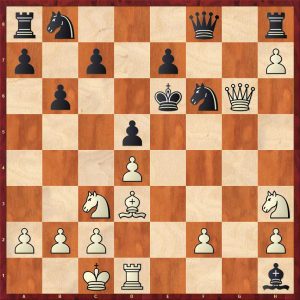
7.gxh7+! Nxh5 8.Bg6#
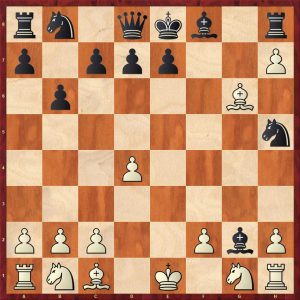
Part 4 Combinative Mates (Queen & Rook)
Although the author states in the introduction that knowing the names of the mates does not matter, I tend to disagree as a name gives some poetry. There are about 24 different types of mates in this chapter. The reviewer will show a few positions to give the reader a taste:
Here is a famous opening trap with Anastasia’s Mate:
Bukowska – Kopec
MK Cafe Cup Koszalin (7) 1997
1.e4 e5 2.Nf3 Nc6 3.Bb5 a6 4.Ba4 Nf6 5.0-0 Nxe4 6.Re1 Nc5 7.Nxe5 Nxe5 8.Rxe5+ Be7 9.Nc3 Nxa4 10.Nd5 0-0 11.Nxe7+ Kh8
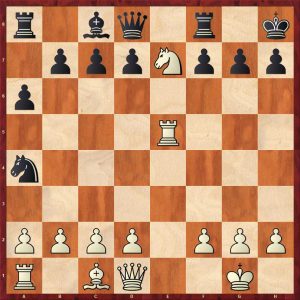
12.Qh5! d5 (12…g6 13.Qh4 is nasty) 13.Qxh7!+ 1-0 (13…Kxh7 14.Rxh5#
The Arabian mate is a common mating motif:
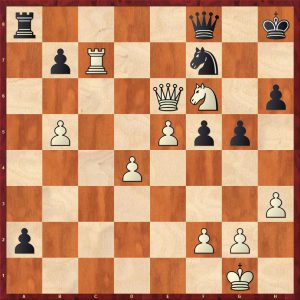
Black’s a pawn is unstoppable, but white has seen further.
37.Qxf7! a1=Q+ 38.Kh2 and black’s extra queen cannot prevent the inevitable mate on h7! 38…Qxf7 39.Rxf7 b6 40,Rh7#
The back row mate (aka corridor mate) is probably one of the commonest tactical themes in chess:
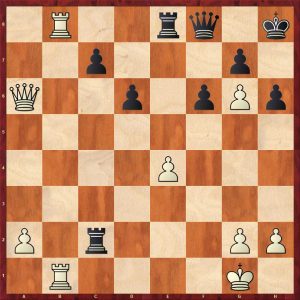
Capablanca muffed the coup de grâce by playing 29.Qa8?? and black resigned obviously believing the future world champion. Black could have saved the game with 29…Rxa2!
White could have won with 29.Rxe8 or even simpler 29.Qb5! Rxb8 (29…c6 30.Rxe8 Qxe8 31.Qb8 Rc1+ 32.Kf2) 30.Qxb8 Kg8 31.Qb3+ or 31.Qa7
Here is another beautiful example of a back rate coupled with a self block mate:
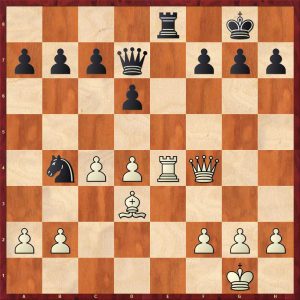
White played 21.Qf5! (with a double threat on the black queen and h7) 21…Re6 (21…Qxf5 22.Rxe8#;Qa4 23.b3! Rxe4 24,bxa4 Re1+ 25.Bf1 wins;21…Qd8 22.Re7!! capturing the rook allows 23.Qxh7+ Kf8 24.Qh8#) 22.d5! Nxd3 23.dxe6 fxe6 24.Qxe6+ Qxe6 25.Rxe6 (25…Nxb2 26.Re7 wins by harvesting the black pawns) Kf7 26.Re2 1-0
No anthology of tactics would be complete without the Opera Mate:
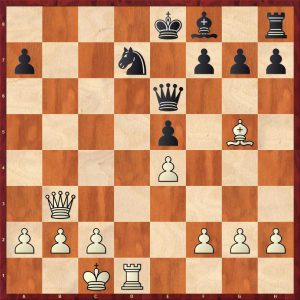
Probably one of the most famous finishes 16.Qb8!+ Nxb8 17.Rd8#
This is an instructive example of Cozio’s Mate:
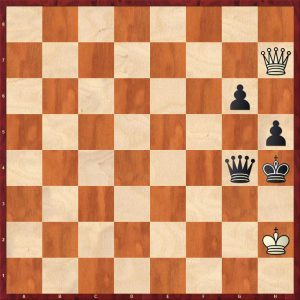
White looks to be in trouble here. However after 1.Qe7+ Qg5 (1…g5 2.Qe1+ Qg3+ 3.Qxg3#) 2.Qe4+ Qg4 3.Qe3!! black is in zugzwang and will be mated.
Here is an example of Marshall’s mate from a modern game:
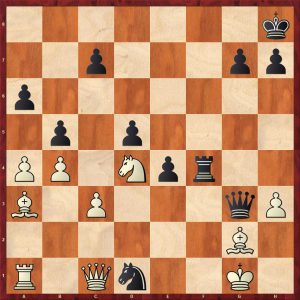
White played 36.Ne2?? (36.Qxd1 Rf2 37.Qf1 Rxf1 38.Rxf1 wins as a rook and three pieces will overcome a queen and 3 pawns) overlooking 36…Rf1+ 37.Kxf1 Qf2#
Part 5 Combinative Mates (Bishop, Knight & Pawn)
There are about 11 different types of mates in this chapter. The reviewer will show a few positions to give the reader a taste:
Here is the original Boden’s Mate:
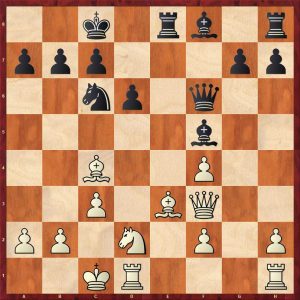
13…d5! 14.Bxd5 Qxc3+ 15.bxc3 Ba3#
Here is an example of the Pony Express mate from Joseph Blackburne:
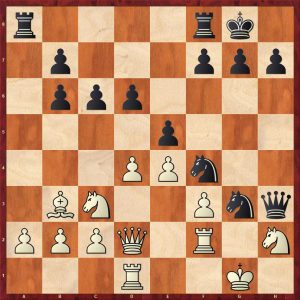
White appears to have plenty of pieces round his king, but 20…Qg2+! 21.Rxg2 Nh3# is a pretty mate
Here is a example of the Suffocation Mate deep in the ending:

White has just played 84.h7! and black resigned. After 84…Kg7 85.h8Q+! Kxh8 86.Bh6 the black king is trapped in the corner. White mates with the moves 87.Bf8 followed by 88.Kg5, 89.Kh6 and 90.Bg7#
In summary, I recommend this book as an excellent training manual for practising pattern recognition of common mating patterns.
To make the book even better, I would have added a short section on common tactical motifs such as forks, skewers & pins.

FM Richard Webb, Basingstoke, Hampshire, 20th July 2021
Book Details :
- Hardcover : 450 pages
- Publisher:Thinkers Publishing; 1st edition (1 Mar. 2019)
- Language: English
- ISBN-10: 949251043X
- ISBN-13: 978-9464201055
- Product Dimensions: 17.02 x 23.5 cm
Official web site of Thinkers Publishing
